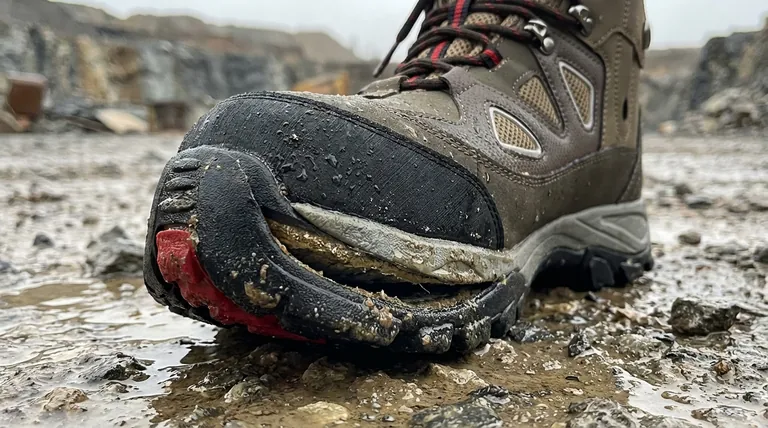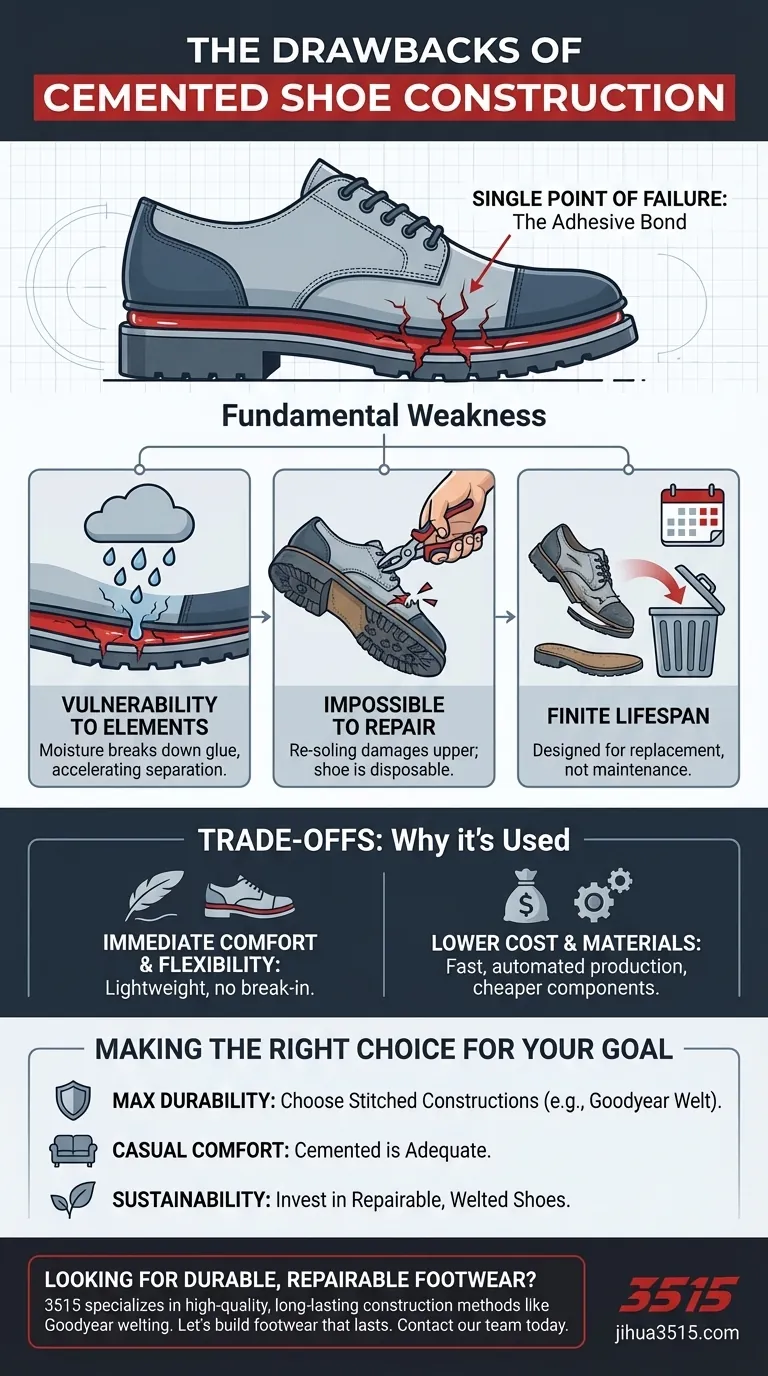The primary drawbacks of cemented shoe construction are its lack of durability, the near impossibility of repair, and its common association with lower-quality materials. This method, which relies on industrial adhesive to bond the sole to the upper, creates a shoe that is often lightweight and flexible but fundamentally disposable.
Cemented construction represents a trade-off: it sacrifices long-term durability and the potential for repair in favor of lower manufacturing costs and immediate out-of-the-box comfort.

The Fundamental Weakness: The Adhesive Bond
The core of a cemented shoe's limitations lies in the glue that holds it together. Unlike stitched methods, this adhesive bond is a single point of failure that is highly susceptible to wear and environmental stress.
A Single Point of Failure
In a cemented shoe, the entire connection between the upper and the sole depends on one layer of adhesive. There is no structural stitch or welt providing a secondary layer of security.
Over time, the constant flexing from walking, combined with environmental factors, can weaken this bond, leading to the sole peeling away from the upper.
Vulnerability to the Elements
Moisture is a primary enemy of the adhesive bond. Water can work its way into the seam, breaking down the glue and accelerating separation.
This makes cemented shoes a poor choice for consistently wet or rugged conditions where more robust, moisture-resistant construction methods are required.
The Challenge of Repair and Longevity
Perhaps the most significant drawback of cemented construction is that it effectively eliminates the possibility of extending the shoe's life through repair. This design philosophy prioritizes replacement over maintenance.
Why Re-soling Fails
Re-soling a shoe requires removing the old outsole completely. With cemented construction, this means forcibly pulling the glued sole away from the upper.
This process almost invariably damages or tears the upper material to which the sole was attached, making it impossible to create a secure bond for a new sole. The shoe is simply not designed to be taken apart.
A Disposable Lifespan
Because they cannot be reliably re-soled, cemented shoes have a finite, disposable lifespan. Once the original sole wears out, the entire shoe must be discarded.
This contrasts sharply with welted construction, where a worn-out sole can be replaced multiple times, making the shoe a long-term investment.
Understanding the Trade-offs
While its drawbacks are significant for longevity, the cemented method is chosen for specific reasons related to cost, weight, and initial feel.
The Benefit of Immediate Comfort
Cementing allows for a very lightweight and flexible shoe right out of the box. Without the rigid components of a welt, the shoe requires little to no break-in period.
This is why the method is ubiquitous in sneakers, athletic shoes, and casual footwear where flexibility and low weight are prioritized over ultimate durability.
The Connection to Cost and Materials
Cemented construction is a fast, simple, and highly automated process, which significantly lowers manufacturing costs.
It is often paired with less expensive upper materials that would not structurally support a welt. The construction method is typically a reliable indicator of the shoe's overall quality tier.
Making the Right Choice for Your Goal
Understanding shoe construction allows you to purchase footwear that aligns with your actual needs and expectations for value.
- If your primary focus is maximum durability and repairability: Seek out shoes with Goodyear welt or similar stitched constructions.
- If your primary focus is lightweight comfort and affordability for casual use: Cemented construction is often perfectly adequate and appropriate for this purpose.
- If your primary focus is sustainability and long-term value: Avoid cemented footwear and invest in a shoe built with a repairable, welted construction.
By looking past the surface appearance and understanding the foundation of its construction, you can choose a shoe that will truly serve its intended purpose.
Summary Table:
| Drawback | Key Impact |
|---|---|
| Lack of Durability | Single adhesive bond is a weak point, prone to separation. |
| Vulnerable to Moisture | Water can break down the glue, accelerating failure. |
| Near Impossible to Repair | Re-soling damages the upper, making the shoe disposable. |
| Limited Longevity | Finite lifespan; cannot be re-soled like welted shoes. |
Looking for durable, repairable footwear for your business?
As a large-scale manufacturer, 3515 produces a comprehensive range of high-quality footwear for distributors, brand owners, and bulk clients. We specialize in durable construction methods like Goodyear welting, ensuring your products offer superior longevity and value to your customers. Our production capabilities encompass all types of shoes and boots, from rugged work boots to stylish, long-lasting casual wear.
Let's build footwear that lasts. Contact our team today to discuss your manufacturing needs.
Visual Guide

Related Products
- Safety Footwear Wholesale Manufacturer for Custom OEM/ODM Production
- Wholesale Safety Footwear Manufacturer for Bulk & Custom OEM Orders
- Premium Suede Sport Safety Shoes for Wholesale & Bulk Orders
- Wholesale Durable 6-Inch Work Boots | Custom & Private Label Manufacturer
- Wholesale Customizable Safety Boots Durable & Protective Footwear Manufacturing
People Also Ask
- How long can you wear safety boots? The Lifespan is Determined by Wear, Not Time
- How do safety shoes contribute to cost savings for companies? A Strategic Investment in Risk and Cost Management
- Is safety-toe as good as steel toe? Choose the Right Protection for Your Job
- Do snake bite boots work? Your Ultimate Guide to Effective Snake Bite Protection
- What are OSHA approved shoes? Understanding the Correct Standards for Workplace Safety



















